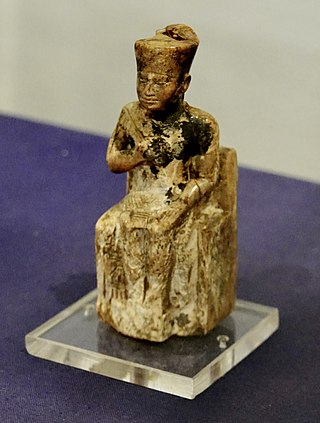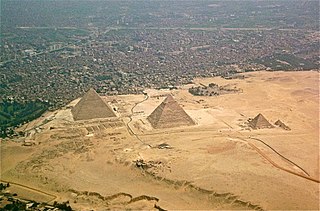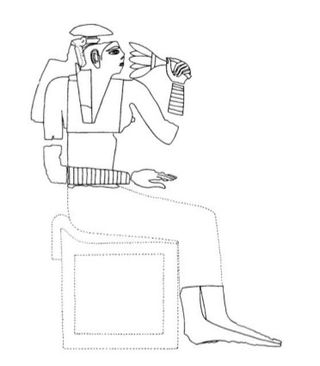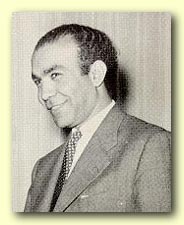Cheops or Khufu, was an ancient Egyptian monarch.
Cheops or CHEOPS may also refer to:
Cheops or Khufu, was an ancient Egyptian monarch.
Cheops or CHEOPS may also refer to:

The Great Pyramid of Giza is the largest Egyptian pyramid and the tomb of Fourth Dynasty pharaoh Khufu. Built in the early 26th century BC during a period of around 27 years, the pyramid is the oldest of the Seven Wonders of the Ancient World, and the only one to remain largely intact. It is the most famous monument of the Giza pyramid complex, in the Pyramid Fields of the Memphis and its Necropolis UNESCO World Heritage Site, in Giza, Egypt. It is at the most Northern end of the line of the 3 Pyramids of Giza.

Khufu or Cheops was an ancient Egyptian monarch who was the second pharaoh of the Fourth Dynasty, in the first half of the Old Kingdom period. Khufu succeeded his father Sneferu as king. He is generally accepted as having commissioned the Great Pyramid of Giza, one of the Seven Wonders of the Ancient World, but many other aspects of his reign are poorly documented.

Khafre was an ancient Egyptian pharaoh of the Fourth Dynasty during the Old Kingdom. He was the son of Khufu and the successor of Djedefre.
Khufu or Cheops was an Ancient Egyptian pharaoh.

The Fourth Dynasty of ancient Egypt is characterized as a "golden age" of the Old Kingdom of Egypt. Dynasty IV lasted from c. 2613 to 2494 BC. It was a time of peace and prosperity as well as one during which trade with other countries is documented.

The Westcar Papyrus is an ancient Egyptian text containing five stories about miracles performed by priests and magicians. In the papyrus text, each of these tales are told at the royal court of king Khufu (Cheops) by his sons. The story in the papyrus usually is rendered in English as, "King Cheops and the Magicians" and "The Tale of King Cheops' Court". In German, into which the text of the Westcar Papyrus was first translated, it is rendered as Die Märchen des Papyrus Westcar.

The Giza Plateau is a limestone plateau in Giza, Egypt, the site of the Fourth Dynasty Giza pyramid complex, which includes the pyramids of Khufu, Khafre and Menkaure, the Great Sphinx, several cemeteries, a workers' village and an industrial complex. It forms the northernmost part of the 16,000 ha Pyramid Fields in the Western Desert edge of the Nile Valley that are part of the UNESCO World Heritage Site, Memphis and its Necropolis.

Major General Richard William Howard Howard Vyse was a British soldier and Egyptologist. He was also Member of Parliament (MP) for Beverley and Honiton.

The Khufu ship is an intact full-size solar barque from ancient Egypt. It was sealed into a pit at the foot of the Great Pyramid of pharaoh Khufu around 2500 BC, during the Fourth Dynasty of the ancient Egyptian Old Kingdom. Like other buried Ancient Egyptian ships, it was part of the extensive grave goods intended for use in the afterlife. The Khufu ship is one of the oldest, largest and best-preserved vessels from antiquity. It is 43.4 metres (142 ft) long and 5.9 metres (19 ft) wide, and has been identified as the world's oldest intact ship, and described as "a masterpiece of woodcraft" that could sail today if put into a lake or a river.
Djedi is the name of a fictional ancient Egyptian magician appearing in the fourth chapter of a story told in the legendary Westcar Papyrus. He is said to have worked wonders during the reign of king (pharaoh) Khufu.
(Al-) Minya may refer to:

Hetepheres I was a queen of Egypt during the Fourth Dynasty of Egypt who was a wife of one king, the mother of the next king, the grandmother of two more kings, and the figure who tied together two dynasties.
The Upuaut Project was a scientific exploration of the so-called "air shafts" of the Great Pyramid of Giza, which was built as a tomb for Fourth Dynasty pharaoh Khufu. The Upuaut Project was led by Rudolf Gantenbrink under the auspices of the German Archaeological Institute in Cairo during three campaigns. According to Bauval, it was "marshalled into two stages: the first stage, to improve ventilation in the Great Pyramid using the shafts in the King's Chamber, and the second stage to explore the presumed 'abandoned' shafts in the Queen's Chambers." The latter was accomplished by sending a miniature mobile robot designed by Rudolph Gantenbrink, named Upuaut-2, into the shafts.

Ankhhaf was an Egyptian prince and served as an overseer during the reign of the Pharaoh Khufu, who is thought to have been Ankhhaf's half-brother. One of Ankhaf's titles is also as a vizier, but it is unknown which pharaoh he would have held this title under. He lived during Egypt's 4th Dynasty.

Kamal el-Mallakh was a famous Egyptian archaeologist who was among the Egyptian antiquities inspectors who discovered the King Khufu Solar ship in 1954.
Iynefer can refer to:

Several ancient Egyptian solar ships and boat pits were found in many ancient Egyptian sites. The most famous is the Khufu ship now preserved in the Grand Egyptian Museum. The full-sized ships or boats were buried near ancient Egyptian pyramids or temples at many sites. The history and function of the ships are not precisely known. They might be of the type known as a "solar barge", a ritual vessel to carry the resurrected king with the sun god Ra across the heavens. However, some ships bear signs of being used in water, and it is possible that these ships were funerary barges.

The Giza Solar boat museum was dedicated to display the reconstructed Khufu ship, a solar barque of pharaoh Khufu. It was constructed between 1961 and 1982, just a few meters from where the Khufu ship was found, on the southern side of the Great Pyramid, on the Giza Plateau in Egypt
The Herodotus Machine was a machine described by Herodotus, a Greek historian born in Halicarnassus, Caria. Herodotus claims this invention enabled the ancient Egyptians to construct the pyramids. The contraption supposedly allowed workers to lift heavy building materials. Herodotus is believed to have encountered the device while traveling through Egypt. With limited reference and no true schematics, this machine has stimulated many historians' theories of how the ancient Egyptians were able to create pyramids.
Nefertkau is the name of several ancient Egyptian women: